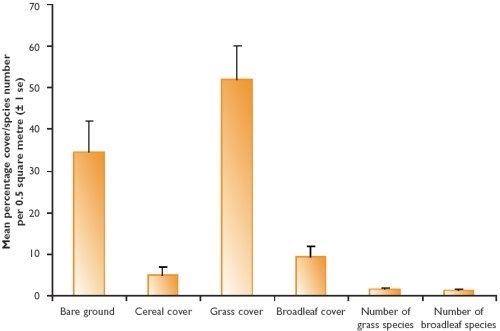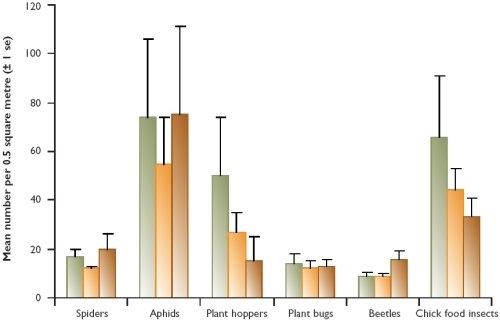Key findings
- Plant diversity was poor on set-aside fields and invertebrate numbers were generally low. However, set-aside still had more plants and insects than a typical arable crop.
- Owing to the low numbers found, invertebrate abundance was similar between fields that were sprayed or cut and unmanaged fields.
- Spraying is the preferred management option. It allows vegetation to die back slowly and while doing so provides invertebrate food and shelter during the nestling period, and is harmless to mammals and birds compared with cutting.
Under MAFF regulations in the 1990s, cereal stubbles put into rotational set-aside could be managed to control weeds by cutting at any time and ploughing after 1 May. Cutting vegetation early in the summer can result in direct mortality of mammals and birds, and the destruction of nests and breeding habitat.
After pressure from us and other conservation bodies, set-aside regulations were changed. Currently under Defra regulations there must be a green cover on the stubble over winter, which in most cases is natural regeneration. This cover can be sprayed off with glyphosate (Roundup) from 15 April, but to achieve best weed control on most fields, it is not normally sprayed until late May. Ploughing and cutting should not be carried out before 15 July but, if essential, steps should be taken to minimise the disturbance to wildlife. These changes have allowed flexible field management with green cover over winter, providing food for birds during a period when it can be scarce and, as ploughing and cutting should not be carried out until July, this safeguards the period when most ground-nesting birds have eggs or fledglings.
In our study, we looked at the effects of spraying or cutting set-aside on vegetation and invertebrates. We examined 31 fields, each on separate farms in southern England, of which 21 were sprayed, five had the vegetation top-cut leaving a sward of at least 25 centimetres in height, and five were unmanaged. We measured vegetation cover before management (cutting or spraying) in late May and sampled invertebrate groups known to be eaten by birds before and after management (early June) at 50 metres into the field.
Figure 1: Percentage cover of vegetation groups and number of species in 31 set-aside fields

Before management, the fields had on average 20-40% bare ground, 40-60% grass cover, 7-11% broadleaf cover and 1-7% volunteer cereals (see Figure 1). Although the plant cover may seem high, the floral diversity was very low with just one to two grass species and one to two broadleaf species per sample. The availability of insects was broadly related to the level of plant cover, but this was not always the case. Insect abundance was remarkably unaffected by cutting or spraying (see Figure 2).
Figure 2: Bird food numbers in relation to set-aside management type

Although set-aside was not originally a conservation initiative, but was designed to reduce excess grain production, set-aside fields have often proved to be important in supplying food in the form of grain and seeds to arable birds over winter. In summer, although invertebrate numbers were often very low, they were as good as or better than those found in arable fields (see Review of 2005, page 51).
In summer, the open vegetation attracts ground-nesting birds and mammals, therefore spraying is the preferred option because some vegetation structure is retained compared with cutting, inhibiting nest predation, as has been found with skylarks. Spraying also allows a slow die-back of vegetation allowing plant-feeding and other invertebrates to survive in the fields during the period when chicks require an insect-rich diet. Overall, set-aside when used in conjunction with other conservation improvements such as game cover and grass-flower strips, can give additional benefit to farmland wildlife.